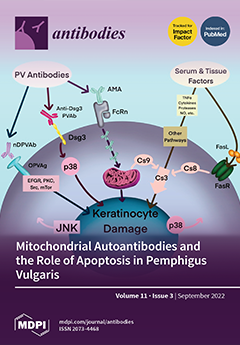Open AccessArticle
Anticalin N- or C-Terminal on a Monoclonal Antibody Affects Both Production and In Vitro Functionality
by
Nicolas Aubrey, Valérie Gouilleux-Gruart, Christine Dhommée, Julie Mariot, Fanny Boursin, Nicolas Albrecht, Cécile Bergua, Cécile Croix, Mäelle Gilotin, Eloi Haudebourg, Catherine Horiot, Laetitia Matthias, Caroline Mouline, Laurie Lajoie, Audrey Munos, Gilles Ferry, Marie-Claude Viaud-Massuard, Gilles Thibault and Florence Velge-Roussel
Cited by 2 | Viewed by 2529
Abstract
Bispecific antibodies (BsAbs) represent an important advance in innovative therapeutic strategies. Among the countless formats of BsAbs, fusion with molecules such as anticalins linked to a monoclonal antibody (mAb), represents an easy and low-cost way to obtain innovative molecules. We fused an anticalin
[...] Read more.
Bispecific antibodies (BsAbs) represent an important advance in innovative therapeutic strategies. Among the countless formats of BsAbs, fusion with molecules such as anticalins linked to a monoclonal antibody (mAb), represents an easy and low-cost way to obtain innovative molecules. We fused an anticalin against human fibronectin to a molecule biosimilar to trastuzumab (H0) or rituximab (R0), in four different positions, two on the N terminal region of heavy or light chains and two on the C terminal region. The eight BsAbs (H family (HF) 1 to 4 and R family (RF) 1 to 4) were produced and their affinity parameters and functional properties evaluated. The presence of anticalin did not change the glycosylation of the BsAb, shape or yield. The antigenic recognition of each BsAb family, Her2 for HF1 to 4 and CD20 for RF1 to 4, was slightly decreased (HF) or absent (RF) for the anticalin N-terminal in the light chain position. The anticalin recognition of FN was slightly decreased for the HF family, but a dramatic decrease was observed for RF members with lowest affinity for RF1. Moreover, functional properties of Abs, such as CD16 activation of NK, CD32-dependent phagocytosis and FcRn transcytosis, confirmed that this anticalin position leads to less efficient BsAbs, more so for RF than HF molecules. Nevertheless, all BsAbs demonstrated affinities for CD16, CD32 and FcRn, which suggests that more than affinity for FcRs is needed for a functioning antibody. Our strategy using anticalin and Abs allows for rapid generation of BsAbs, but as suggested by our results, some positions of anticalins on Abs result in less functionality.
Full article
►▼
Show Figures






